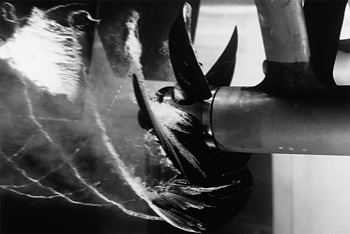Self noise
Any vessel equipped with a hydroacoustic system (for example echo sounder or sonar) will produce more or less self noise.
There are many sources of such self noise. It is necessary to analyse the different sources of self-noise on a vessel, and find out how each source can affect the noise
level of the hydroacoustic instruments.
Machinery noise
The main contributor to machinery noise is usually the main engine on board the vessel. The contribution from auxiliary machinery may, however, be considerable, especially if it is in poor shape. The machinery noise can be transmitted to the transducer as:
| • | Structure-borne noise through the ship structure and the transducer mountings. |
| • | Water-borne noise through the hull into the water to the transducer. |
Electrical noise
Modern vessels are normally equipped with a lot of electric instruments such as hydroacoustic systems, radars, navigation
systems, and communication equipment. Any electric instruments may in some cases cause electrical interference and noise. International regulations and certifications are used to control and reduce this, but even these are limited if the electrical
systems are poorly installed and/or maintained.
Propeller noise
Propeller noise is often the main source of noise at higher vessel speeds. Variable pitch propellers or fast moving propellers usually make more noise than fixed propellers or slow moving propellers.
Propeller noise is usually water-borne. In some cases, however, shaft vibrations or vibrations in the hull near the propeller may be structure-borne to the transducer. If a propeller blade is damaged, this may increase the noise considerably.
Propeller cavitation is a severe source of noise. "Singing" propellers might be a source of noise, which interferes at discrete frequencies. In some cases static discharge from the rotating propeller shaft may be quite disturbing.
Cavitation

Cavitation is the formation of small air bubbles close to the transducer face. The bubbles appear because the local pressure becomes negative during parts of the acoustic pressure cycles. The cavitation threshold increases with the hydrostatic pressure. The noise is made when the bubbles implode.
Cavitation noise may appear near extruding objects at higher speeds, but more often it is caused by the propellers. Propeller cavitation is a severe source of noise. The cavitation starts when the water flows in the same direction as the propeller blades. This is where the propeller blades move downwards.
In some cases a resonant phenomenon is set up in a hole near the hull. This sound will have a discrete frequency, while all other flow noise will have a wide frequency spectrum.
(Image from U. S. Navy in the public domain.)
Flow noise
The upper water layers of the sea contain a myriad of small air bubbles created by the breaking waves. When the hull moves through water it will cause a disturbance, and this will generate friction. The friction zone is called the flow boundary layer. The water flow in this boundary layer may be laminar or turbulent.
| • | The laminar flow is a nicely ordered, parallel movement of the water. |
| • | The turbulent flow is a disorderly flow pattern, full of eddies. |

| A | Turbulent flow |
| B | Laminar flow |
| C | Air bubbles |
Air bubbles absorb and reflect the sound energy, and they may in worst cases block the sound transmission altogether.
The boundary layer increases in thickness when it becomes turbulent. The boundary layer is thin in the forward part of the vessel hull, and increases as it moves aft. The thickness depends on ships speed and on the roughness of the hull. All objects sticking out from the hull, or dents in the hull, will disturb the flow and will increase the thickness of the
boundary layer. When the flow speed is high, the turbulence can be violent enough to destroy the integrity of the water. Small voids or cavities in the water will occur and this is called cavitation.
Rattle noise
Rattle noise may be caused by loose objects in the vicinity of the transducer, like fixing bolts. The rattle may also come from loose objects inside the hull.